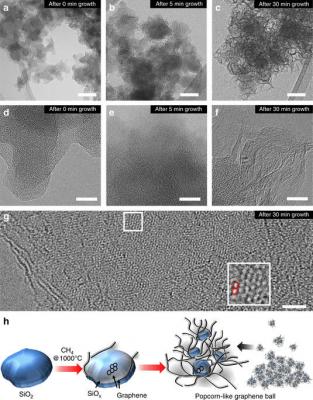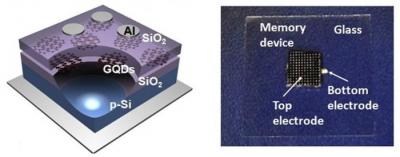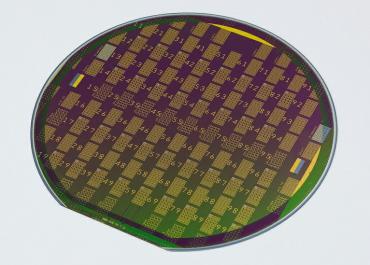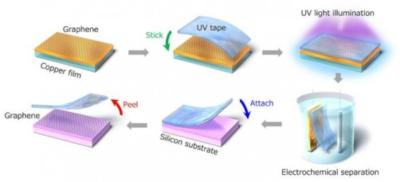![]() Samsung Group, based in South Korea, is a multinational conglomerate company involved with electronics, mobile phones, displays (LCD, Plasma and OLEDs), materials, insurance, finance, advertising, heavy industry and more.
Samsung Group, based in South Korea, is a multinational conglomerate company involved with electronics, mobile phones, displays (LCD, Plasma and OLEDs), materials, insurance, finance, advertising, heavy industry and more.
Samsung is researching graphene and at least in 2013 it was the company with the most graphene related patents in the world. The company is developing a wide range of graphene-based solutions.
Samsung Town
Seoul
South Korea
Researchers develop adhesive tape that can transfer 2D materials like graphene in an easier, cheaper and less-damaging way
Researchers from Kyushu University, Nitto Denko Corporation, Tokyo Institute of Technology, Osaka University, National Institute of Advanced Industrial Science and Technology (AIST) and Samsung Electronics have developed a tape that can be used to stick 2D materials to many different surfaces, in an easy and user-friendly way.
Transfer process of monolayer graphene from Cu(111)/sapphire to a SiO2/Si substrate using the UV tape. Image from Nature Electronics
“Transferring 2D materials is typically a very technical and complex process; the material can easily tear, or become contaminated, which significantly degrades its unique properties,” says lead author, Professor Hiroki Ago of Kyushu University's Global Innovation Center. “Our tape offers a quick and simple alternative, and reduces damage.”
Researchers design rGO-based nerve gas sensor using human scent receptors
Researchers from Seoul National University and Samsung Electronics have developed a sensitive and selective nerve gas sensor using human scent receptors. It reliably detected a substitute for deadly sarin gas in simulated tests.
Nerve gases are often very potent, requiring highly sensitive sensors to detect them quickly and accurately. One method of boosting sensitivity combines human scent receptors with nanomaterials such as reduced graphene oxide to create a "bioelectronic nose." But since these nerve gases are still highly dangerous even in laboratory settings, many scientists rely on safer, substitute molecules instead. In the case of the sarin or soman nerve agents, dimethyl methylphosphonate (DMMP) is a common replacement. Previously, the receptor protein hOR2T7 has been used to detect DMMP, but it could only do so when the nerve agent substitute was in a liquid form, rather than as a gas. So, the research team wanted to design a "nose" of their own that was both highly sensitive and selective for the gaseous form, using nanodiscs containing the hOR2T7 receptor.
Samsung rumored to launch phone with graphene battery next year
 Samsung may be in the race to develop a graphene-based alternative to lithium-ion batteries for its phones. Rumors are going around claiming that the Company hopes to have at least one phone with a graphene battery ready next year or by 2021.
Samsung may be in the race to develop a graphene-based alternative to lithium-ion batteries for its phones. Rumors are going around claiming that the Company hopes to have at least one phone with a graphene battery ready next year or by 2021.
The word is that these graphene-based batteries will be capable of a full charge in under a half-hour, but they still need to raise capacities while lowering costs. In 2017, Samsung said its researchers developed a "graphene ball" material that enables five times faster charging speeds than standard lithium-ion batteries.
XG Sciences to expand with new graphene production facility
XG Sciences, a US-based developer and producer of graphene flakes, has announced its plan to invest millions in expanding its Lansing-area facilities. The company will start operating out of new 64,000 square-foot facility in Vevay Township in March.

The company was formed in 2006 based on work out of Michigan State University. The company's technology can be used in automotive batteries and as wire coatings in electronics to prevent microchips from overheating. Some of the material has been used in Samsung phones as a thermally conductive adhesive, said current CEO Philip Rose. Rose also said the expansion marks the first phase in a move toward larger scale commercialization for the company.
Samsung's "graphene balls" improve the performance and charging time of Li-ion batteries
Samsung has announced the development of a unique "graphene ball" that could make lithium-ion batteries last longer and charge faster. In fact, Samsung Advanced Institute of Technology (SAIT) said that using the new graphene ball material to make batteries will increase their capacity by 45% and make their charging speed five times faster. It was also said that batteries that use graphene ball can maintain a temperature of 60 degrees Celsius that is required for use in electric cars.

SAIT's team used a chemical vapor deposition process to grow a graphenesilica assembly, called a graphene ball. Each graphene ball is composed of a SiOx nanoparticle center and surrounding graphene layers, constituting a 3D popcorn-like structure. The graphene-ball coating improves cycle life and fast charging capability by suppressing detrimental side reactions and providing efficient conductive pathways.
Samsung collaborates with Sungkyunkwan University to develop amorphous graphene synthesis technology
 A joint research conducted by Samsung Advanced Institute of Technology and Sungkyunkwan University in Korea yielded an original technology for synthesizing amorphous graphene. Amorphous graphene is a material with different properties than crystalline graphene. It has lower conductivity and according to the researchers it can be suitable for various industries including desalination.
A joint research conducted by Samsung Advanced Institute of Technology and Sungkyunkwan University in Korea yielded an original technology for synthesizing amorphous graphene. Amorphous graphene is a material with different properties than crystalline graphene. It has lower conductivity and according to the researchers it can be suitable for various industries including desalination.
The team stated that the latest achievement is significant in that it has expanded the range of two-dimensional materials, It will be possible to discover new areas of application by utilizing the new characteristics of the amorphous material.
Will Samsung's Galaxy S7 sport a graphene-enhanced battery?
 In June 2015, researchers at the SAIT (Samsung's Advanced Institute of Technology) found a way to prolong the life of the standard lithium-ion batteries by using a new silicon cathode material "coded with high-crystalline graphene". Recent talk around the web suggests that this discovery may find its way to Samsung's Galaxy S7 and grant it a 5-day battery.
In June 2015, researchers at the SAIT (Samsung's Advanced Institute of Technology) found a way to prolong the life of the standard lithium-ion batteries by using a new silicon cathode material "coded with high-crystalline graphene". Recent talk around the web suggests that this discovery may find its way to Samsung's Galaxy S7 and grant it a 5-day battery.
While the research is indeed impressive, and will hopefully be integrated in actual products in the future, it is important to say that we have no real indication that Samsung is close to commercializing their findings. Since the S7 is not scheduled for release until March 2016, there's still time for surprises...
Samsung may be able to double Li-ion battery life using graphene
 Samsung researchers reportedly developed materials that can be used to double the capacity of Li-ion batteries. The key to the more efficient batteries is a new graphene-based cathode material. It is a new silicon cathode material "coded with high-crystalline graphene". As deployed in its lithium-ion batteries the new cathodes produce cells "with twice as much capacity as ordinary lithium-ion batteries," according to various reports.
Samsung researchers reportedly developed materials that can be used to double the capacity of Li-ion batteries. The key to the more efficient batteries is a new graphene-based cathode material. It is a new silicon cathode material "coded with high-crystalline graphene". As deployed in its lithium-ion batteries the new cathodes produce cells "with twice as much capacity as ordinary lithium-ion batteries," according to various reports.
This research presents a dramatic improvement of the capacity of lithium-ion batteries by applying a new synthesis method of high-crystalline graphene to a high-capacity silicon cathode. Samsung's team used silicon cathodes instead of graphite ones; this is not a novel approach, since many previous studies have also used it. The challenge, however, is that the silicon can expand or contract during the battery charging and discharging cycles. Samsung addressed this issue by creating a process to grow graphene cells directly on the silicon in layers that can adjust to allow for the silicon's expansion: "The graphene layers anchored onto the silicon surface accommodate the volume expansion of silicon via a sliding process between adjacent graphene layers. When paired with a commercial lithium cobalt oxide cathode, the silicon carbide-free graphene coating allows the full cell to reach volumetric energy densities of 972 and 700âWhâl-1 at first and 200th cycle, respectively, 1.8 and 1.5 times higher than those of current commercial lithium-ion batteries."
Samsung developed graphene quantum dots based flash memory devices
Researchers are developing flash memory devices that store the charge in nanocrystals instead of the usually used polysilicon layers. These kinds of devices are less sensitive to local defects and offer high-density memory potential.

Researchers from Samsung Electronics (and Korea's Kyung Hee University) are now developing similar flash devices based on graphene quantum dots (GQDs). The performance of such a device is promising, with an electron density that is comparable to semiconductor and metal nanocrystal based memories. Those flash memory can also be made flexible and transparent.
Samsung announces a breakthrough large-area graphene synthesis process
Samsung announced that they developed a breakthrough large-area graphene synthesis process. The company says this is one of the most significant breakthroughs in graphene research ever, and they expect this new technique to accelerate graphene commercialization towards applications in electronics.

This process was discovered by researchers at Samsung's Advanced Institute of Technology (SAIT) in collaboration with Sungkyunkwan University. The process can be used to grow single crystal graphene on the current semiconductor wafer scale while maintaining graphene's electric and mechanical properties.
Pagination
- Page 1
- Next page
